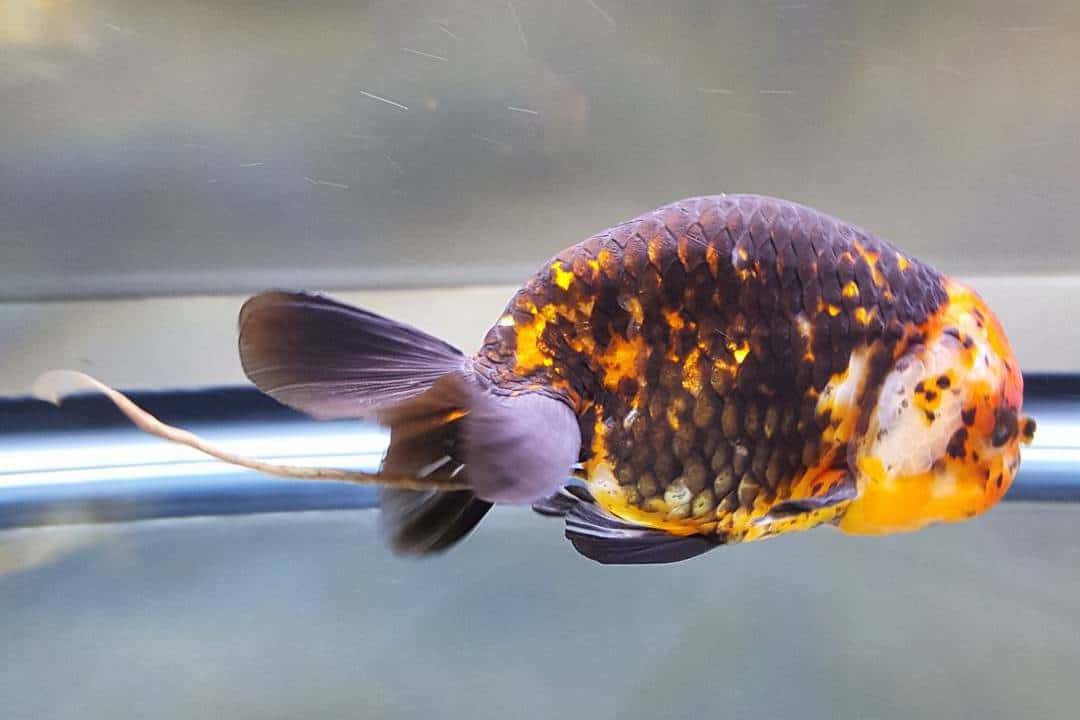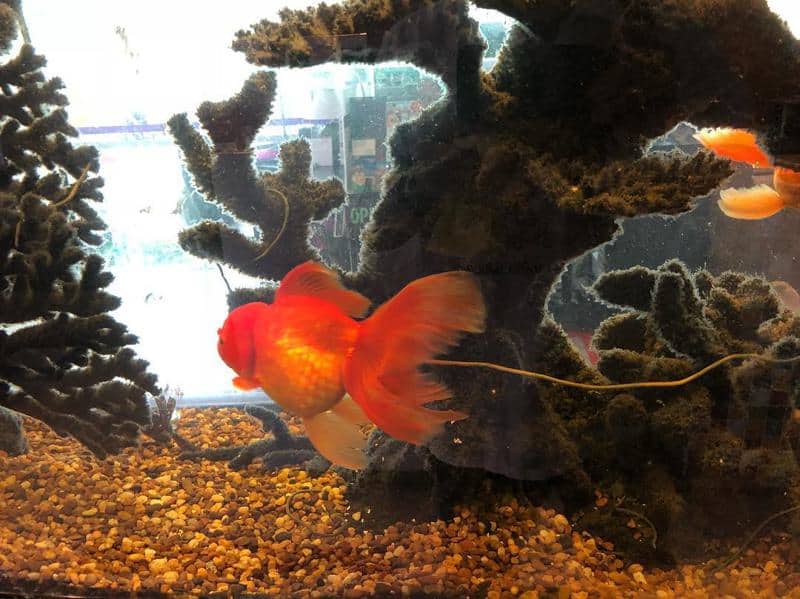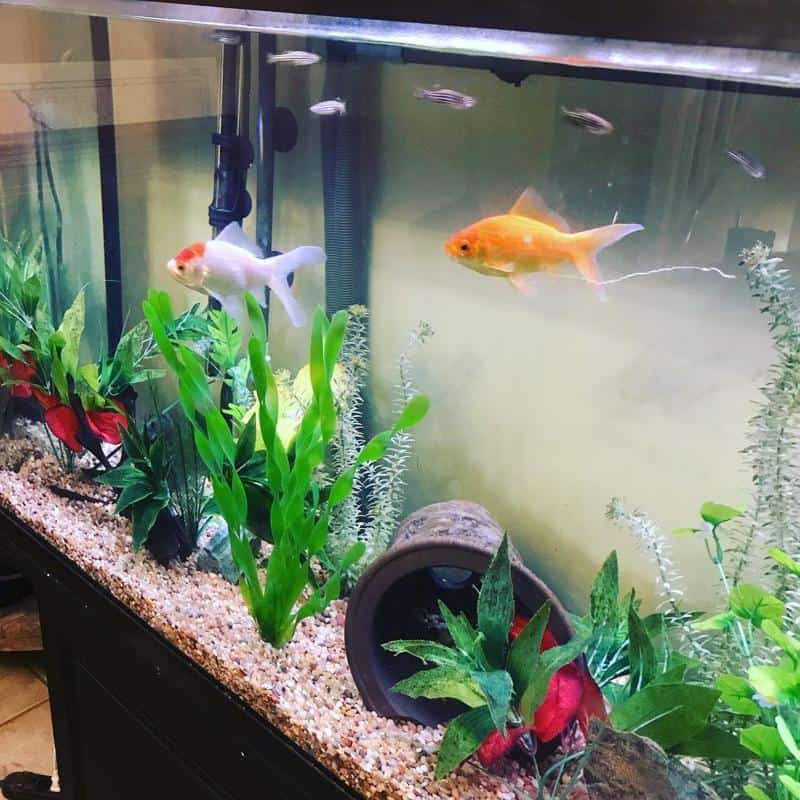If you’re a goldfish keeper or are interested in taking up this rewarding hobby, there’s one thing you’ll have to learn about – and that’s goldfish poop.
Goldfish poop is important since it can tell you all about the eating habits and health of your goldfish, allowing you to keep them in good health. And to help you learn everything you need to know about it, here’s our comprehensive guide to goldfish poop.
The Goldfish Digestive System
To understand why it’s so important to monitor your goldfish’s poop and understand what different colors and consistencies mean, we need to start by saying a few words about their digestive system.
Goldfish have an unusual digestive system in that they don’t have a stomach.
After a goldfish swallows its food, it passes straight into the first intestine – also known as the intestinal bulb – where the food is broken down by enzymes. There, carbohydrates and fat are absorbed.
What’s left then passes into the second intestine where protein is also absorbed.
Finally, the waste matter that remains is ejected from the vent or anus.
Why Do We Need to Worry About Goldfish Poop?

Since the food a goldfish eats is not digested in a stomach but rather passes straight through the goldfish’s intestines and out the other end, a goldfish’s poop can tell us a lot about the fish’s health.
As a result, by paying attention to the color and consistency of the poop, we can tell whether the fish is eating properly and is in good health – or if it has dietary deficiencies, bacterial infections, parasites or other health issues.
This means an experienced goldfish keeper will know what healthy poop looks like – and also what other types of poop can tell you and what to do to rectify various situations if all is not well. So let’s start by looking at what goldfish poop should look like.
What Does Healthy Goldfish Poop Look Like?
The first thing to understand is what goldfish poop is supposed to look like – so how can you spot healthy goldfish poop?
Goldfish poop should come out in pellets, it should always be dark, and once passed, it will sink to the bottom of the aquarium.
Since the food passes through the fish’s intestines and out the other end largely unchanged, it will take on some of the color of the food the fish has been eating.
So for example, if the fish has been eating a higher quantity of plant matter, the poop will have a greenish hue. However, it will still be a dark green – and if it isn’t, it indicates that there’s some kind of problem.
Unhealthy goldfish poop can come out in various other colors, and the consistency can also be different, so now let’s move on to thinking about what other colors and consistencies goldfish poop can be and what it tells you about the health of your goldfish.
What Kinds of Goldfish Poop Can Indicate Problems?
Long Stringy Poop

Most people will have seen goldfish with long stringy poop hanging out of the back of them, and many people may even think this is normal – but it isn’t.
In the wild, goldfish are grazers that eat constantly, but in an aquarium, they will just keep eating as long as food is available, which means it’s easy to overfeed them.
When this happens, they can become constipated, and one common symptom is long, stringy poop.
To solve the problem, stop feeding the fish for two days to allow the fish to pass the food it has in it, and then try to adopt better feeding practices to prevent the problem from recurring.
Feeding the fish blanched deshelled peas – after the two-day fast – can also help clear the blockage.
Alternatively, constipation can be caused by dirty aquarium water, so to rectify it and prevent it from happening again, clean the tank and then make sure you keep it clean.
Another possibility is that the fish doesn’t have a balanced diet containing all the nutrients and fiber it needs, in which case you should try to improve the fish’s diet.
Bubbles in The Poop
If you notice air bubbles in the fish’s poop, it indicates that the oxygen levels in the water are low. When this happens, goldfish swim to the surface and take gulps of air, and the air is then ejected in the poop.
To rectify this problem – and to avoid it happening again – make sure the water in the tank has high enough oxygen levels. Ensure the surface has plenty of agitation, increase the surface area of the water and don’t keep too many fish for the size of tank you have.
You can also put in an air stone, although this is a more short-term solution – a better option is to add a bubbler to the aquarium.
Another possibility is that the water is too warm since warmer water has a lower O2 content – so you can also try lowering the temperature of the water to around 68-70°F, although not lower than this.
Cloudy Poop
If your fish has cloudy poop coming out behind it as it swims, it means it has diarrhea. There’s no cure for this, but it is usually caused by a dirty tank.
You can avoid it by keeping the tank clean, so if your fish shows signs of diarrhea, make sure the water is clean and feed the fish a proper diet – and the diarrhea should clear up.
After that, maintain good aquarium hygiene to prevent it from happening again.
White Poop

There are several reasons a goldfish’s poop can be white, but the most common is that it has a poor diet – and when this occurs, the poop will probably be long and stringy too.
Goldfish do best when fed a balanced diet consisting of high-quality goldfish flakes or pellets, some live food such as bloodworms and some plant matter such as blanched vegetables.
This means the first thing to do is to make sure your goldfish is getting everything it needs in its food.
If you are sure your goldfish is receiving a healthy and balanced diet, it’s possible that it has either a bacterial infection – other symptoms to look out for include loss of appetite, lethargy and bloating.
To medicate a bacterial infection, you can try adding antibiotics to the water.
Another possibility is a parasitic infection, which can be treated with special anti-parasite medication.
Brown or Red Poop
If your goldfish’s poop is overly brown or red, it may also be a sign of bacterial infection, in which case you can medicate with antibiotics.
However, remember that dark poop with a red or brown hue can just be related to the food a fish has eaten recently and is nothing to worry about.
Black Poop
Sometimes, medication can cause a goldfish’s poop to come out closer to black. However, if this happens and you know you are medicating your fish, it’s nothing to be concerned about.
Blackish poop can also be caused by eating dead worms, something you will know about if you are giving them dead worms as food.
Green Poop
If your fish’s poop is overly green, it is a sign that it has a diet that is high in vegetation. This is fine if you have just given it a meal of vegetables – but if the poop is always green, it’s a sign that you need to give it a more balanced diet and not feed it just plant matter.
Clear Poop
If the poop that comes out of your goldfish is clear or pale, it’s an indication that your fish is underfed and malnourished.
As we’ve mentioned several times already, goldfish need a balanced diet – and that means one that contains enough protein and fat. When they don’t get enough of all the nutrients they require, it can cause their poop to come out clear.
Another factor can be if you give your fish processed human food to eat – if you do, and their poop is clear, you should stop at once and return them to a balanced diet suitable for goldfish.
No Poop
If your goldfish doesn’t poop, it can mean it’s constipated, which may be due to overfeeding or an unbalanced diet that doesn’t contain enough fiber.
Again, the solution to this is to put the fish on a two-day fast to clear its system and then to ensure it receives a healthy balanced diet in future to prevent the problem from returning. Blanched shelled peas can also help clear the blockage.
However, bear in mind that healthy goldfish poop quickly sinks to the substrate, so make sure you haven’t missed any before concluding that your goldfish is blocked up.
How Can You Keep Your Goldfish Healthy?
If you want to keep your goldfish in good health, there are several things you can do – and the first is feeding them the proper diet.
As we’ve already mentioned, this should include high-quality goldfish flakes or pellets, live food and plant matter. Make sure you don’t overfeed them to ensure they don’t become constipated.
At the same time, tank hygiene is important. This is true for all fish, but it’s particularly vital for goldfish due to their unusual digestive systems and the amount of poop they generate.
To do this, you should clean the aquarium at least once a week, and you should change 20% of the water every two weeks.
Finally, make sure the water is kept at the right temperature and is properly oxygenated. If the water doesn’t contain enough oxygen, the fish will resort to gulping air at the surface, resulting in bubbles in their poop.
Most experts agree that suitable temperatures for keeping goldfish in an aquarium are between around 68 and 75°F, with the ideal temperature lying in the middle of this range (although they can survive outside in waters as cold as 40°F).
If you are sure the water is being properly oxygenated but your fish are still gulping air, it may mean there are too many fish for the size of the aquarium.
Feeding Tip
Some goldfish owners rotate the food they give to the fish, allowing them to monitor their poop – and so their health – even more closely.
If you feed your fish plant matter one day, you can see how quickly the plant matter comes back out as poop as well as if it’s the right color. Then you can give your fish something higher in protein the next day, and the poop color will change accordingly.
This gives you an easy way of keeping an eye on their digestive system and spotting any problems early, allowing you to take action if you notice any issues.
Also Read:
- How Often to Feed Goldfish?
- What Kind of Water Do Goldfish Need?
- Aquarium Fish that Eats Poop
- Goldfish Ammonia Poisoning
FAQs
How Often Should You Feed Your Goldfish?
Since goldfish are natural grazers, the ideal situation would be to give them a little food every hour.
However, since this is hardly practical for most people, a better solution is to feed them twice a day – and to only give them as much food as they can finish in two minutes.
If, after two minutes of feeding, food remains in the aquarium, you should remove whatever is left.
What Does It Mean if Your Goldfish Eats Its Own Poop?
Goldfish don’t usually eat their own poop, so if you see yours doing this, it means there’s a problem.
The most likely cause is that it is underfed, in which case you should increase the amount of food you give it.
However, note that goldfish will sometimes eat poop and then spit it back out again. This is just because they mistake the poop for food but quickly realize it isn’t. If you see this kind of behavior, it’s nothing to worry about.
Do Goldfish Pee?
Yes and no. Like any other animal, goldfish need to discharge ammonia and nitrates. However, these are passed through the gills, which is quite a different method from most people’s idea of peeing – although it serves the same purpose.
What Are the Symptoms of Constipation in Goldfish?
Symptoms of constipation in goldfish include no poop, long, thick poop, bloating, reduced appetite, lethargy and clamped fins.
What Do Goldfish Eat in The Wild?
In the wild, goldfish graze constantly, eating small crustaceans, insects and plant matter.
How Long Does It Take for A Goldfish to Process Food?
Food can be swallowed and pass through a goldfish’s digestive system in as little as 30 minutes.
Do Goldfish Poop a Lot?
Yes, due to their lack of stomach, compared to other fish, goldfish generate a lot of poop.
Something All Goldfish Keepers Should Know About
When it comes to keeping goldfish, knowing all about their poop is surprisingly important, and it lets you keep a close eye on the digestive systems and overall health of your fish.
By knowing what healthy poop looks like, you can judge how well your fish are doing – and by knowing what different kinds of unhealthy poop look like, you can quickly spot and diagnose any problems before they become too serious.